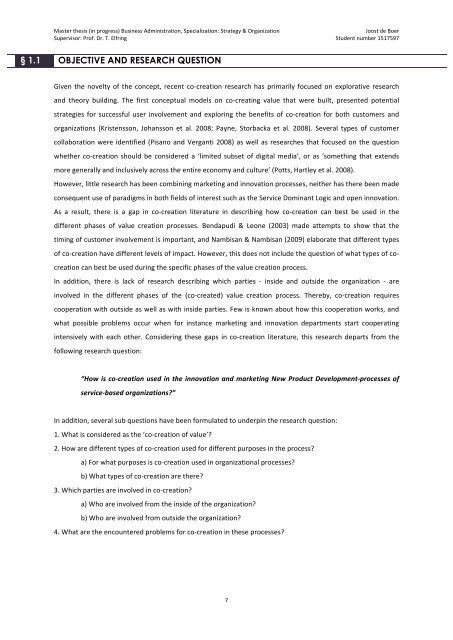Download PDF (English) - Future Ideas
Download PDF (English) - Future Ideas
Download PDF (English) - Future Ideas
Create successful ePaper yourself
Turn your PDF publications into a flip-book with our unique Google optimized e-Paper software.
Master thesis (in progress) Business Administration, Specialization: Strategy & Organization <br />
Supervisor: Prof. Dr. T. Elfring <br />
Joost de Boer <br />
Student number 1517597 <br />
§ 1.1 OBJECTIVE AND RESEARCH QUESTION<br />
Given the novelty of the concept, recent co-‐creation research has primarily focused on explorative research <br />
and theory building. The first conceptual models on co-‐creating value that were built, presented potential <br />
strategies for successful user involvement and exploring the benefits of co-‐creation for both customers and <br />
organizations (Kristensson, Johansson et al. 2008; Payne, Storbacka et al. 2008). Several types of customer <br />
collaboration were identified (Pisano and Verganti 2008) as well as researches that focused on the question <br />
whether co-‐creation should be considered a ‘limited subset of digital media’, or as ‘something that extends <br />
more generally and inclusively across the entire economy and culture’ (Potts, Hartley et al. 2008). <br />
However, little research has been combining marketing and innovation processes, neither has there been made <br />
consequent use of paradigms in both fields of interest such as the Service Dominant Logic and open innovation. <br />
As a result, there is a gap in co-‐creation literature in describing how co-‐creation can best be used in the <br />
different phases of value creation processes. Bendapudi & Leone (2003) made attempts to show that the <br />
timing of customer involvement is important, and Nambisan & Nambisan (2009) elaborate that different types <br />
of co-‐creation have different levels of impact. However, this does not include the question of what types of co-creation<br />
can best be used during the specific phases of the value creation process. <br />
In addition, there is lack of research describing which parties -‐ inside and outside the organization -‐ are <br />
involved in the different phases of the (co-‐created) value creation process. Thereby, co-‐creation requires <br />
cooperation with outside as well as with inside parties. Few is known about how this cooperation works, and <br />
what possible problems occur when for instance marketing and innovation departments start cooperating <br />
intensively with each other. Considering these gaps in co-‐creation literature, this research departs from the <br />
following research question: <br />
“How is co-‐creation used in the innovation and marketing New Product Development-‐processes of <br />
service-‐based organizations?” <br />
In addition, several sub questions have been formulated to underpin the research question: <br />
1. What is considered as the ‘co-‐creation of value’? <br />
2. How are different types of co-‐creation used for different purposes in the process? <br />
a) For what purposes is co-‐creation used in organizational processes? <br />
b) What types of co-‐creation are there? <br />
3. Which parties are involved in co-‐creation? <br />
a) Who are involved from the inside of the organization? <br />
b) Who are involved from outside the organization? <br />
4. What are the encountered problems for co-‐creation in these processes? <br />
7





